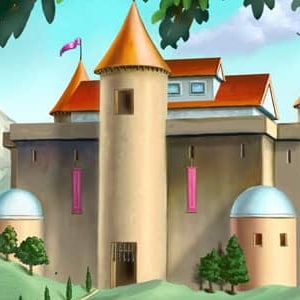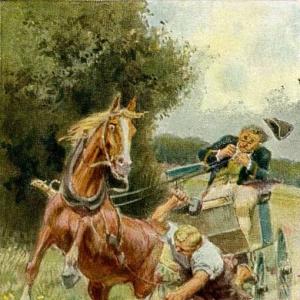Reading time: 7 min
There was once on a time a King who had a daughter, and he caused a glass mountain to be made, and said that whosoever could cross to the other side of it without falling should have his daughter to wife. Then there was one who loved the King’s daughter, and he asked the King if he might have her. „Yes,“ said the King; „if you can cross the mountain without falling, you shall have her.“ And the princess said she would go over it with him, and would hold him if he were about to fall. So they set out together to go over it, and when they were half way up the princess slipped and fell, and the glass-mountain opened and shut her up inside it, and her betrothed could not see where she had gone, for the mountain closed immediately. Then he wept and lamented much, and the King was miserable too, and had the mountain broken open where she had been lost, and though the would be able to get her out again, but they could not find the place into which she had fallen. Meanwhile the King’s daughter had fallen quite deep down into the earth into a great cave. An old fellow with a very long gray beard came to meet her, and told her that if she would be his servant and do everything he bade her, she might live, if not he would kill her. So she did all he bade her. In the mornings he took his ladder out of his pocket, and set it up against the mountain and climbed to the top by its help, and then he drew up the ladder after him. The princess had to cook his dinner, make his bed, and do all his work, and when he came home again he always brought with him a heap of gold and silver. When she had lived with him for many years, and had grown quite old, he called her Mother Mansrot, and she had to call him Old Rinkrank. Then once when he was out, and she had made his bed and washed his dishes, she shut the doors and windows all fast, and there was one little window through which the light shone in, and this she left open. When Old Rinkrank came home, he knocked at his door, and cried, „Mother Mansrot, open the door for me.“ – „No,“ said she, „Old Rinkrank, I will not open the door for thee.“ Then he said,
„Here stand I, poor Rinkrank,
On my seventeen long shanks,
On my weary, worn-out foot,
Wash my dishes, Mother Mansrot.“
„I have washed thy dishes already,“ said she. Then again he said,
„Here stand I, poor Rinkrank,
On my seventeen long shanks,
On my weary, worn-out foot,
Make me my bed, Mother Mansrot.“
„I have made thy bed already,“ said she. Then again he said,
„Here stand I, poor Rinkrank,
On my seventeen long shanks,
On my weary, worn-out foot,
Open the door, Mother Mansrot.“
Then he ran all round his house, and saw that the little window was open, and thought, „I will look in and see what she can be about, and why she will not open the door for me.“ He tried to peep in, but could not get his head through because of his long beard. So he first put his beard through the open window, but just as he had got it through, Mother Mansrot came by and pulled the window down with a cord which she had tied to it, and his beard was shut fast in it. Then he began to cry most piteously, for it hurt him very much, and to entreat her to release him again. But she said not until he gave her the ladder with which he ascended the mountain. Then, whether he would or not, he had to tell her where the ladder was. And she fastened a very long ribbon to the window, and then she set up the ladder, and ascended the mountain, and when she was at the top of it she opened the window. She went to her father, and told him all that had happened to her. The King rejoiced greatly, and her betrothed was still there, and they went and dug up the mountain, and found Old Rinkrank inside it with all his gold and silver. Then the King had Old Rinkrank put to death, and took all his gold and silver. The princess married her betrothed, and lived right happily in great magnificence and joy.
 Learn languages. Double-tap on a word.Learn languages in context with Childstories.org and Deepl.com.
Learn languages. Double-tap on a word.Learn languages in context with Childstories.org and Deepl.com.Backgrounds
Interpretations
Adaptions
Summary
Linguistics
„Old Rinkrank“ is a lesser-known fairy tale collected by the Brothers Grimm, Jacob and Wilhelm, in their famous compilation, „Grimms‘ Fairy Tales“ (original title: „Kinder- und Hausmärchen“). The Brothers Grimm were German scholars, linguists, and cultural researchers who lived in the late 18th and early 19th centuries. Their collection of fairy tales, first published in 1812, has become an essential part of the Western literary canon.
The Brothers Grimm gathered stories from various sources, including oral traditions, written texts, and from their acquaintances. Their primary aim was to preserve the German cultural heritage and share the moral and cultural values contained within these stories. The tales were revised and expanded in several editions, with the final edition published in 1857, containing over 200 stories.
„Old Rinkrank“ is part of this collection and, like many other Grimm fairy tales, explores various themes, such as love, resilience, and the battle between good and evil. Despite not being as widely recognized as other Grimm tales like „Cinderella,“ „Snow White,“ or „Hansel and Gretel,“ „Old Rinkrank“ shares the same timeless quality and offers valuable life lessons to its readers.
As with many fairy tales, „Old Rinkrank“ has been passed down through generations and may have been influenced by other similar stories from different cultures. The tale may also have evolved over time, taking on new elements or shedding others as it was retold, before the Brothers Grimm recorded it in their collection.
„Old Rinkrank“ offers various interpretations, touching on themes such as resilience, the power of love, and the consequences of greed.
Resilience and Adaptation: The princess, despite being trapped in the cave and forced to serve Old Rinkrank, demonstrates great resilience and adaptability. She endures years of servitude, biding her time until she can outsmart her captor and regain her freedom. Her ability to survive and maintain hope in such a difficult situation is an important message for readers.
The Power of Love: The young man’s love for the princess motivates him to accept the King’s challenge, and it is the princess’s love for him that makes her join him in the dangerous climb. Moreover, the betrothed’s love remains constant, as he stays with the King throughout the years, searching for the lost princess. This devotion ultimately leads to their reunion and happy ending.
Greed and Its Consequences: Old Rinkrank’s greed for wealth and desire to control the princess lead to his downfall. His hoarding of gold and silver, combined with his need to maintain power over the princess, ultimately backfires when she outsmarts him. This tale serves as a cautionary message about the dangers of greed and the importance of valuing relationships over material possessions.
Empowerment and Self-Reliance: The princess takes control of her situation and orchestrates her escape, proving that she is resourceful and capable. This theme of empowerment and self-reliance is a valuable lesson, encouraging readers to take charge of their own lives and not to rely solely on others for their happiness or freedom.
Good Triumphs Over Evil: In the end, Old Rinkrank, the embodiment of evil in the story, is defeated, and the princess and her true love are reunited. This theme reinforces the notion that good will eventually prevail over evil, providing a sense of hope and optimism to readers.
The fairy tale „Old Rinkrank“ from the Brothers Grimm has been adapted into various forms of media, including:
Operas: There have been several operas based on the tale, including „Rumpelstiltskin“ by British composer David Sawer and „The Weaver’s Wedding“ by Czech composer Bohuslav Martinu.
Plays: The tale has been adapted into stage productions, including „Rumpelstiltskin“ by Robert Neilson Stephens and „The Girl Who Spun Gold“ by Myrna Grant.
Films and television shows: There have been numerous films and television shows based on the tale, including the 1987 film „Rumpelstiltskin“ and the television series „Once Upon a Time,“ which featured Rumpelstiltskin as a recurring character.
Children’s books: The tale has been adapted into numerous children’s books, including „Rumpelstiltskin“ by Paul Galdone and „Tom Tit Tot“ by Evaline Ness.
Art: The tale has also inspired visual artists, including painter John William Waterhouse, who created a painting titled „The Lady of Shalott“ that was inspired by the tale.
These adaptations often put their own spin on the original tale, and vary in terms of their tone and interpretation.
„Old Rinkrank“ is a fairy tale by the Brothers Grimm about a princess who becomes trapped inside a glass mountain. The King, her father, declares that whoever can cross the mountain without falling will win his daughter’s hand in marriage. A young man who loves the princess accepts the challenge, and the princess agrees to help him. However, halfway up the mountain, the princess slips, falls, and is swallowed by the glass mountain.
The princess finds herself in a deep cave, where she meets an old man with a long gray beard. He tells her that if she serves him, she will live; otherwise, he will kill her. The princess obeys, and for years, she cooks, cleans, and does other chores for the old man, known as Old Rinkrank. He uses a magical ladder to climb out of the cave and bring back gold and silver each day.
As the years pass, the princess grows old and becomes known as Mother Mansrot. One day, when Old Rinkrank is out, she decides to trick him. She closes all the doors and windows, leaving only a small one open. When Old Rinkrank returns, he cannot enter his home and tries to peek through the window. Mother Mansrot sees her chance and traps his beard in the window. To free himself, Old Rinkrank must tell her where the magical ladder is hidden.
Mother Mansrot escapes the cave and reunites with her father and betrothed, who have been searching for her all these years. They dig up the mountain, find Old Rinkrank, and execute him, seizing his wealth. The princess finally marries her true love, and they live happily ever after in great luxury and joy.
The fairy tale „Old Rinkrank“ by the Brothers Grimm offers a rich tapestry for linguistic analysis, showcasing the narrative techniques, stylistic elements, and thematic concerns characteristic of the Grimms‘ tales.
Structure and Style: The story follows a traditional fairy tale structure, with an initial problem (the glass mountain challenge), a period of adversity (the princess’s servitude), and a resolution (her escape and return). This structure is mirrored in the language, which is straightforward and functional, driving the narrative forward with a clear sequence of events. Repetition is a major stylistic feature, seen in the repeated dialogue between Mother Mansrot and Old Rinkrank. This repetition serves to emphasize key narrative elements and builds tension, a common technique in oral storytelling.
Characterization through Dialogue: The dialogue between Old Rinkrank and Mother Mansrot is formulaic, reflective of their power dynamic. Old Rinkrank’s repetitive demands and reference to his „seventeen long shanks“ and „weary, worn-out foot“ suggest his vulnerability despite his initial position of power. The princess, taking on the persona of Mother Mansrot, uses short, defiant responses which indicate a shift in agency, marking her transition from passive sufferer to active agent.
Symbolism and Motifs: The glass mountain is a classic fairy tale symbol of an impossible task and the barrier separating the mundane from the magical or otherworldly. It serves as both a literal and metaphorical obstacle. The ladder symbolizes knowledge or an avenue to liberation. Old Rinkrank’s possession of the ladder denotes his control over the princess’s fate, while her eventual possession of it marks her gaining agency.
Themes
Agency and Empowerment: Initially, the princess is a passive character, subjected to the whims of her father, her betrothed, and Old Rinkrank. Her evolution into Mother Mansrot and her eventual rebellion reflect a journey towards self-determination.
Justice and Retribution: The conclusion reflects the fairy tale’s moral underpinnings, where evil (Old Rinkrank’s tyranny) is punished, and good (the princess’s perseverance) is rewarded.
Moral and Didactic Elements: The tale, like many of the Grimms’ stories, carries a moral lesson. It highlights themes of perseverance, cunning, and the eventual triumph of good over evil. The princess’s eventual escape serves as a narrative of hope and justice, resonating with the didactic purpose of many fairy tales.
In essence, the linguistic analysis of „Old Rinkrank“ reveals a blend of narrative and syntactic simplicity geared towards conveying moral lessons and perpetuating cultural values. The tale’s enduring appeal lies in its universal themes and its ability to convey complex ideas through repetitive, yet engaging language.
Information for scientific analysis
Fairy tale statistics | Value |
|---|---|
| Number | KHM 196 |
| Aarne-Thompson-Uther-Index | ATU Typ 311 |
| Translations | DE, EN, ES, PT, IT, JA, NL, PL, RU, TR, VI, ZH |
| Readability Index by Björnsson | 32.6 |
| Flesch-Reading-Ease Index | 81.1 |
| Flesch–Kincaid Grade-Level | 7.6 |
| Gunning Fog Index | 9.9 |
| Coleman–Liau Index | 7.2 |
| SMOG Index | 7.2 |
| Automated Readability Index | 8.2 |
| Character Count | 3.931 |
| Letter Count | 2.997 |
| Sentence Count | 34 |
| Word Count | 768 |
| Average Words per Sentence | 22,59 |
| Words with more than 6 letters | 77 |
| Percentage of long words | 10% |
| Number of Syllables | 933 |
| Average Syllables per Word | 1,21 |
| Words with three Syllables | 16 |
| Percentage Words with three Syllables | 2.1% |

 Facebook
Facebook  Whatsapp
Whatsapp  Messenger
Messenger  Telegram
Telegram Reddit
Reddit















